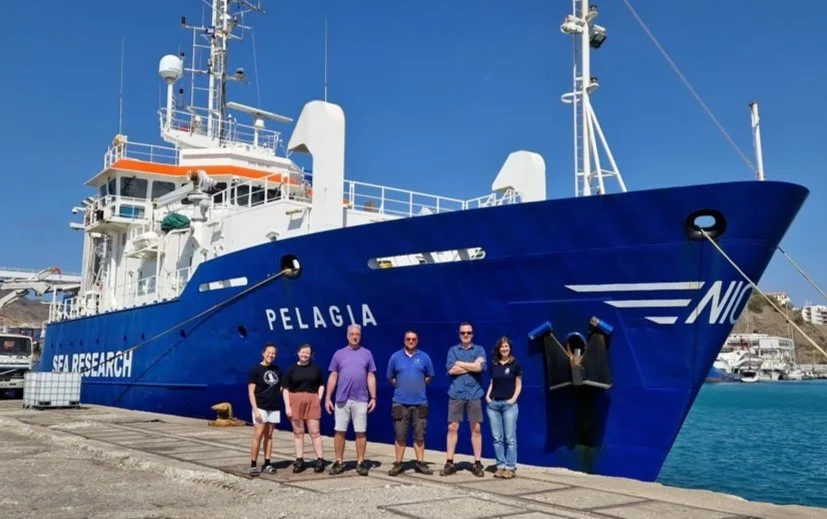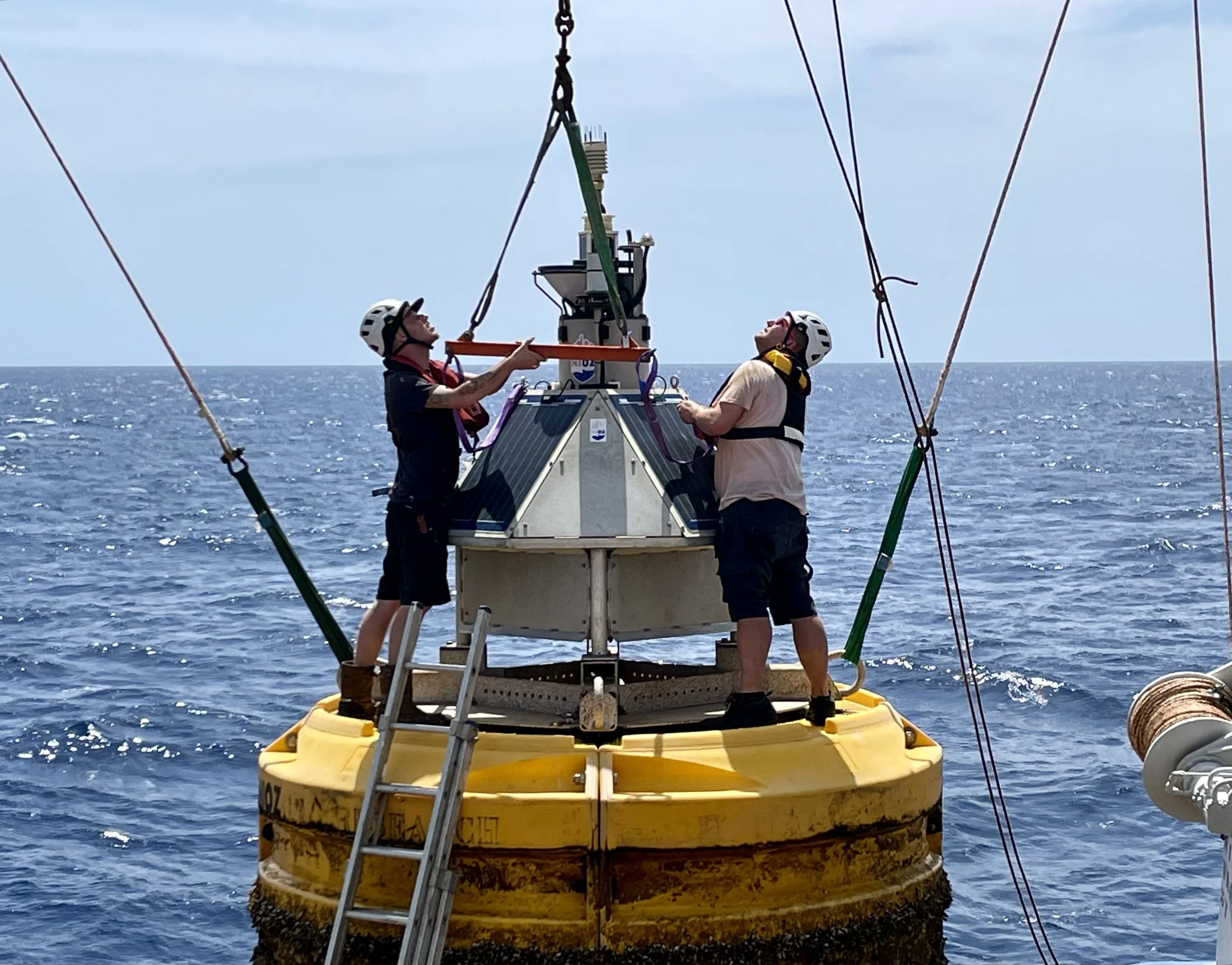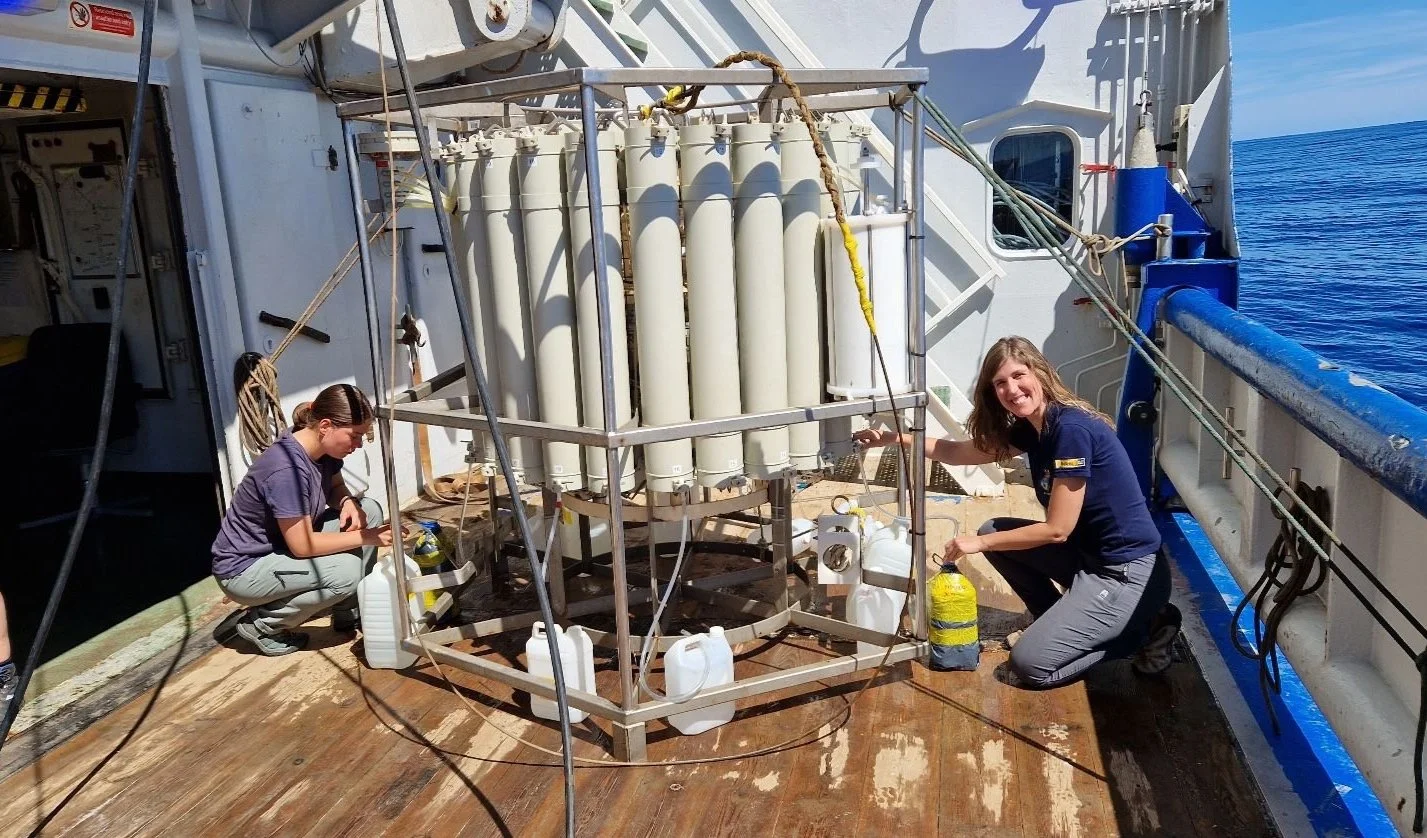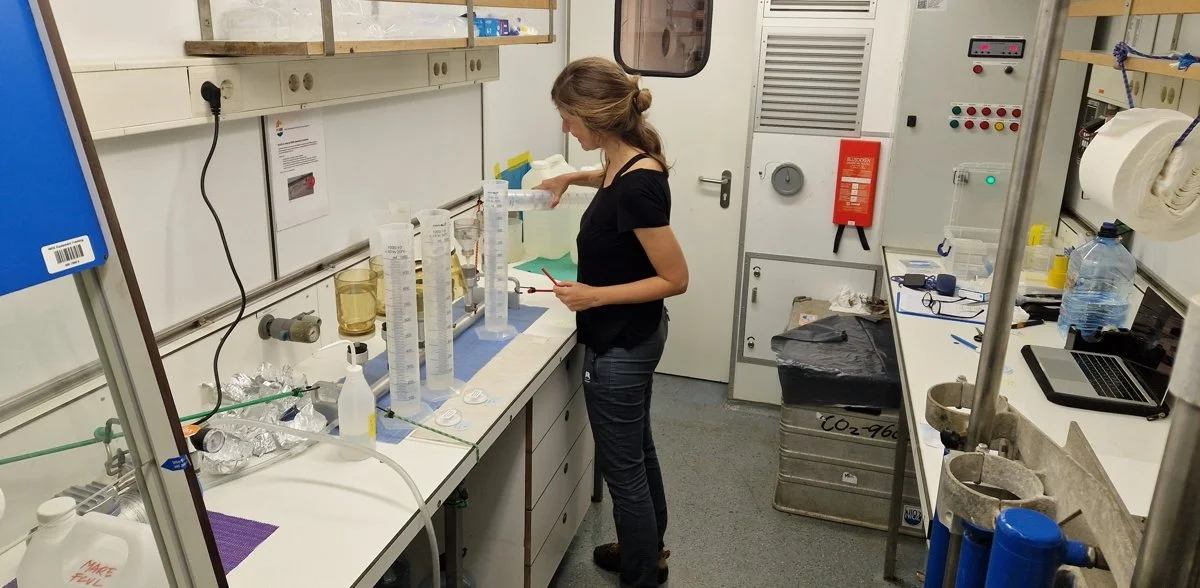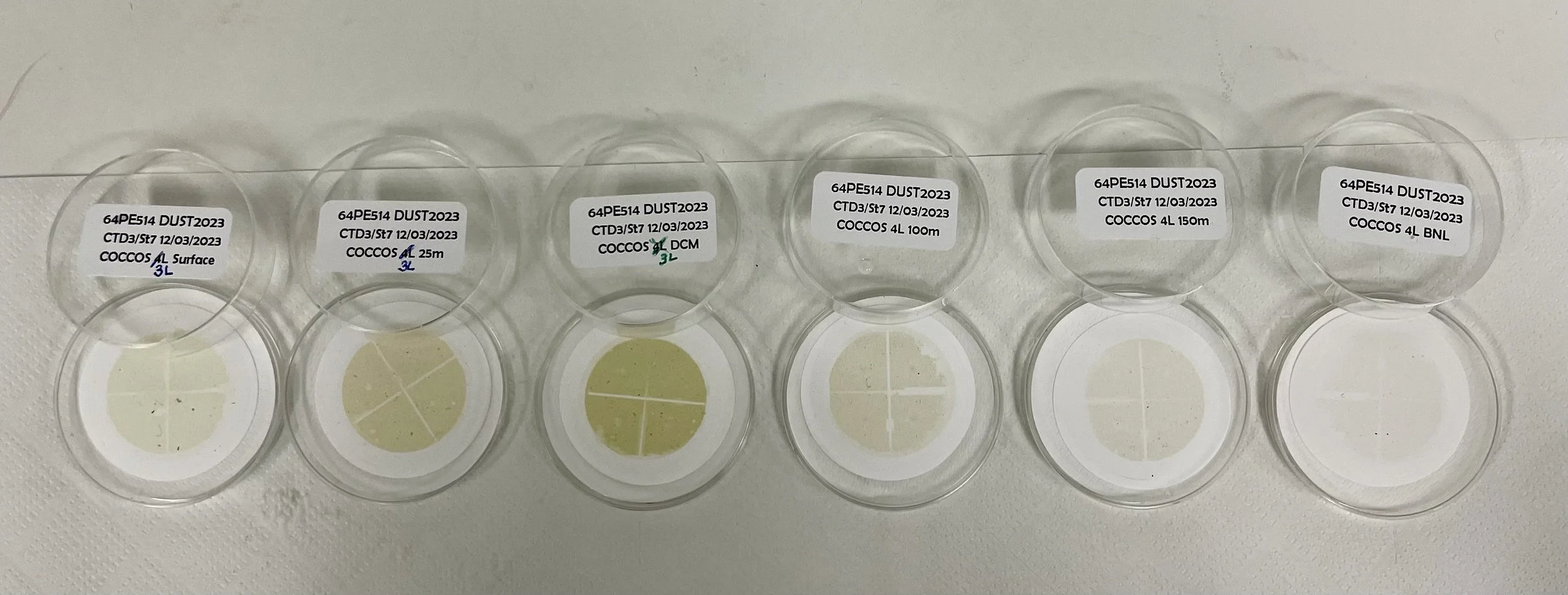In March 2023, PRIMUS member Dr. Catarina Guerreiro (MARE/ARNET/FC.ID) was part of a three-week multidisciplinary expedition led by Prof. Dr. Jan-Berend Stuut (NIOZ/VU) which also included researchers from the NIOZ, MARUM-Bremen, VU Amsterdam, and Utrecht University. In addition to servicing the long-term monitoring instruments that the NIOZ and MARUM have deployed in the NE tropical Atlantic off NW Africa for more than 10 years, the expedition was also aimed at collecting new in situ data to explore the multiple drivers of phytoplankton (export) productivity in this region influenced by the Canary Current EBUS. Being bordered by the single most important source of atmospheric dust emission on a global scale (i.e., the Saharan and Sahel Desert regions), this area provides a “natural laboratory” for investigating and distinguishing the biogeochemical impacts of wind-forced ocean circulation processes from those of African dust deposition.
Catarina Guerreiro and Jan-Berend Stuut (on the left) together with other members of the expedition 64PE514-DUST2023, in front of RV Pelagia at the harbour of Mindelo, Cape Verde (photo credits: Jan-Berend Stuut).
The cruise started in Mindelo (Cape Verde) and included the locations of sediment-trap mooring sites M1 (~12°N/23°W) and CB (~21°W/21°N), where time-series data of particle fluxes (both lithogenic and biogenic) settling along the ocean water column have been collected since 2012 and 1988, respectively. In addition to the submarine sediment traps, these stations also have multiparametric buoys equipped with collectors of atmospheric dust, floating at the surface. The NIOZ long-term sampling strategy consists of combining dust-buoy samples collected from the atmosphere with marine sediment-trap samples to study the drivers, seasonality and magnitude of biological production, as well as the fate of the resulting (exported) biogenic material (organic and inorganic), both in- and outside of the Canary Current EBUS. New samples from the atmosphere, ocean water column and seafloor sediments were also collected during the expedition, using different types of air samplers, CTD-rosette, drifting traps, in-situ pumps, and multicorer.
On the left, the drifting traps about to be deployed to monitor particles fluxes settling along the uppermost 500 m of the ocean (photo credits: Karin Zonneweld); on the right is the multicorer after being recovered back on the deck of ship, bringing nicely preserved sediment core samples which had been collected from the underlying seafloor, at more than 5000 m depth (photo credits: Catarina Guerreiro).
Catarina Guerreiro is currently leading PRIMUS Earth Science 8 to compare biogenic particle flux time-series data (with a focus on coccolithophores) collected from traps M1 and CB, and EO-derived NPP data obtained from PRIMUS. Since coccolithophores are known to be affected by several taphonomical processes (e.g., carbonate dissolution, lateral advection) from the moment they are produced in, and exported from, the photic zone of the ocean, until capture by the traps at 1200 m, we wanted to gain insight on the extent to which the species composition changes during vertical transport. To that aim, Catarina has collected new data of coccolithophore communities living in the photic zone and of coccolith assemblages accumulated in the underlaying seafloor sediments, to calibrate the coccolith flux data from the traps (Guerreiro et al., 2019; Guerreiro et al., 2021).
The three sediment traps recovered from mooring M1, which had been collecting particle fluxes from three distinct water depths at a 4-day resolution offshore NW Africa, for a period of one year (photo credits: Catarina Guerreiro).
Multiparametric floating buoy equipped with a dust collector for measuring dry and wet atmospheric dust deposition at the region of sediment trap mooring M1 (photo credits: Catarina Guerreiro).
To that aim, coccolithophore samples were collected from pre-defined ocean water depths at a total of 8 CTD stations along a transect between 11°N/22°W and 34°N/12°W. To gain insight into the phytoplankton community living in the studied region, subsamples for the study of photosynthetic pigments were also collected at 5 m and at the DCM. The collected dataset will further be analyzed on a multi-parameter approach to gain insight on the links between phytoplankton communities (focus on coccolithophores) and oceanographic and atmospheric circulation patterns off NW Africa, including Saharan dust in the overlaying atmosphere and its subsequent deposition in the ocean. The study will also contribute to unravel the role of ecologically distinct coccolithophore species as potential modulators of the ratio of particulate inorganic- to organic carbon (PIC/POC) ratio in a region where both wind-forced upwelling and Saharan dust deposition are likely to stimulate the biological carbon pump through fueling PP.
To that aim, subsamples were also collected at the surface, DCM, 500 m and bottom layer for the chemical analysis of PIC and POC-PON. Finally, the comparison between the data collected from the ocean water column with surface sediments collected with multicores at Stations M1 and CB will contribute to improve the potential of coccolithophore species as (paleo)environmental proxies in this important EBUS region. We are especially interested in expanding our current understanding of the coccolith export production and PIC/POC ratios in the regions of trap moorings M1 and CB (Guerreiro et al., 2021) with new data collected from the ocean water column and seafloor sediments.
Deployment of the CTD-rosette to monitor variations in temperature, salinity, oxygen, and fluorescence from the surface to the bottom layer of the ocean, and to collect seawater at pre-defined water depths for the ecological and biogeochemical studies (photo credits: Catarina Guerreiro).
Sub-sampling of seawater collected across and underneath the photic zone (500 m and bottom layer) with a CTD-rosette, for the study of coccolithophore communities, phytoplankton pigments, macronutrients, PIC and POC-PON (photo credits: Jan-Berend Stuut).
Catarina filtering the seawater samples from the CTD-bottles, each corresponding to a specific ocean water depth (photo credits: Jan-Berend Stuut).
Residue filters obtained after the filtration of the samples for the coccolithophore study. The image clearly depicts the much higher residue concentrations in the filter corresponding to the deep chlorophyl maximum (DCM), in this case collected at Station 3 (corresponding to the location of sediment trap mooring M1) (photo credits: Catarina Guerreiro).
The collected data will be used to assess the degree to which Saharan dust also contributes to NPP in the Canary Current EBUS, and how this is likely to influence coccolithophore productivity, export, and contribution to the PIC/POC ratio. Insights gained from this study will contribute to answer scientific questions beyond PRIMUS Earth Science Case 8. For more information, check the cruise blogs at the NIOZ and MARUM websites.
